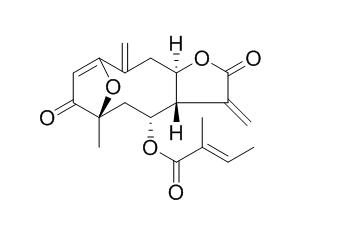Isoatriplicolide tiglate
Isoatriplicolide tiglate acts as an antiproliferation agents particularly against breast and cervical cancers by inducing cell cycle arrest in the S/G2 phase and caspase dependent apoptosis at relatively low (< 10 μg/mL) and high (> 50 μg/mL) concentrations, respectively. Isoatriplicolide tiglate exhibits significant neuroprotective activity against glutamate-induced toxicity at concentrations ranging from 1 uM to 10 uM.
Inquire / Order:
manager@chemfaces.com
Technical Inquiries:
service@chemfaces.com
Tel:
+86-27-84237783
Fax:
+86-27-84254680
Address:
1 Building, No. 83, CheCheng Rd., Wuhan Economic and Technological Development Zone, Wuhan, Hubei 430056, PRC
Providing storage is as stated on the product vial and the vial is kept tightly sealed, the product can be stored for up to
24 months(2-8C).
Wherever possible, you should prepare and use solutions on the same day. However, if you need to make up stock solutions in advance, we recommend that you store the solution as aliquots in tightly sealed vials at -20C. Generally, these will be useable for up to two weeks. Before use, and prior to opening the vial we recommend that you allow your product to equilibrate to room temperature for at least 1 hour.
Need more advice on solubility, usage and handling? Please email to: service@chemfaces.com
The packaging of the product may have turned upside down during transportation, resulting in the natural compounds adhering to the neck or cap of the vial. take the vial out of its packaging and gently shake to let the compounds fall to the bottom of the vial. for liquid products, centrifuge at 200-500 RPM to gather the liquid at the bottom of the vial. try to avoid loss or contamination during handling.
Nutrients.2020, 12(12):3638.
Thorac Cancer.2023, 14(21):2007-2017.
Food Chem.2023, 424:136383.
Front Pharmacol.2022, 13:972825.
Ind. J. Pharm. Edu. Res.2023; 57(3):1132-1139.
Biomed Pharmacother.2024, 171:116166.
J Ethnopharmacol.2020, 269:113752.
Cell Rep.2020, 32(11):108158.
Oncol Rep.2021, 46(1):143.
Institut Pasteur Korea2020, doi: 10.21203.
Related and Featured Products
Molecules. 2012 May 18;17(5):5945-51.
Inhibitory effect and mechanism on antiproliferation of isoatriplicolide tiglate (PCAC) from Paulownia Coreana.[Pubmed:
22609785]
Paulownia coreana has traditionally been used as the medicine and health food in the treatment of cancer and infectious diseases. In the present study, a new antiproliferation agent, Isoatriplicolide tiglate (PCAC) was isolated from the chloroform soluble fraction of the leaves of Paulownia coreana.
METHODS AND RESULTS:
The antiproliferation activities of PCAC plant extract was examined in breast and cervical cancer cell lines in a time-and dose-dependent manners. Our in vitro experiments showed that PCAC suppresses the cell growth and proliferation of cancer cells at a relatively low concentration (< 10 μg/mL) and induces apoptosis at a high concentration (> 50 μg/mL). Western blot analysis showed that concentration higher than 50 μg/mL induces a time-dependent increase in the percentage of apoptotic cells. In this case, PCAC uses both extrinsic and intrinsic pathways for the apoptosis. PCAC treatment decreased the expression of pro-caspase 8, 9, and 3, the main regulators of apoptotic cell death, in MDA-MB-231 cells, accompanied by the activation of caspase 8, 9, and 3. More importantly, PCAC inhibited the in vitro proliferation of six other human breast and cervical cancer cell lines.
CONCLUSIONS:
In conclusion, our data strongly suggest that PCAC acts as an antiproliferation agents particularly against breast and cervical cancers by inducing cell cycle arrest in the S/G2 phase and caspase dependent apoptosis at relatively low (< 10 μg/mL) and high (> 50 μg/mL) concentrations, respectively.
Phytother Res. 2010 Dec;24(12):1898-900.
Neuroprotective effects of a sesquiterpene lactone and flavanones from Paulownia tomentosa Steud. against glutamate-induced neurotoxicity in primary cultured rat cortical cells.[Pubmed:
20683844 ]
The neuroprotective effects of Paulownia tomentosa against glutamate-induced neurotoxicity were studied in primary cultured rat cortical cells. It was found that the aqueous extract of this medicinal plant significantly attenuated glutamate-induced toxicity. In order to clarify the mechanism(s) underlying this neuroprotective effect, the active fractions and components were isolated and identified.
METHODS AND RESULTS:
Five compounds were isolated as the methanol extracts from air-dried flowers of P. tomentosa. Isoatriplicolide tiglate exhibited significant neuroprotective activity against glutamate-induced toxicity at concentrations ranging from 1 μM to 10 μM, and exhibited cell viability of approximately 43-78%.
CONCLUSIONS:
Therefore, the neuroprotective effect of P. tomentosa might be due to the inhibition of glutamate-induced toxicity by the sesquiterpene lactone derivative it contains.



